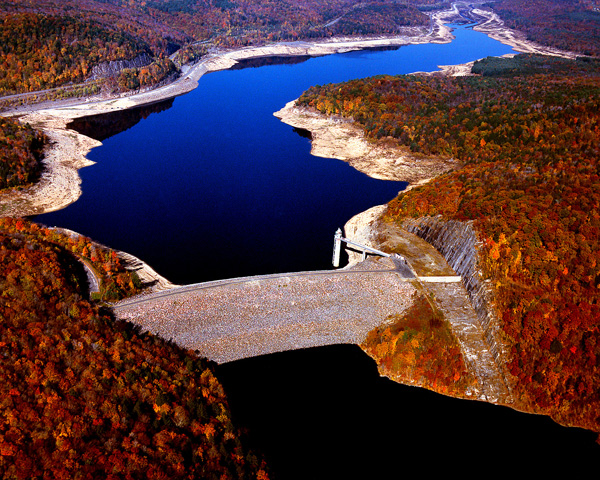
Colebrook River Lake is located on the West Branch of the Farmington River in Colebrook, Conn., and is a part of a network of flood control dams on tributaries of the Connecticut River. Construction of the dam started in May 1965 and was completed in June 1969; costing $14.3 million. The project consists of an earthfill dam with stone slope protection 1,300-feet long and 223-feet high; an earthfill dike 1,240 feet long and 54 feet high; a gated circular outlet tunnel edged in rock 774 feet long and 10 feet in diameter; and a chute spillway cut in rock with a 205-foot-long concrete weir. The weir’s crest elevation is 29 feet lower than the top of the dam. At capacity, the dam can impound a lake of 1,185 acres containing 16.5 billion gallons of water for flood control purposes. This is equivalent to eight inches of water covering its drainage area of 118 square miles. To date, the project has prevented damages of $92.7 million since it was built (as of September 2011).
The dam has substantially reduced flooding along the main stem and West Branch of the Farmington River and downstream flooding along the Connecticut River. The amount of water stored at Colebrook River Lake can fluctuate substantially. The pool, used for both water supply and fishery habitat, normally covers an area of about 750 acres. When filled to capacity with floodwaters, however, the pool covers 1,185 acres. Together, the lake and associated lands stretch out over 1,618 acres in Colebrook and the Massachusetts towns of Sandisfield and Tolland.
The Colebrook River Lake Dam is one of three flood control dams (Mad River and Sucker Brook dams being the others, which are operated and maintained by the state of Connecticut) that were constructed as a result of major flooding from Hurricane Diane that devastated Connecticut in August 1955. The Dubois Cemetery in Sandisfield, Massachusetts, and portions of Route 8 (3.5 miles in Connecticut and 3.4 miles in Massachusetts) were relocated.
The Reservoir Control Center (RCC) is the "nerve center" for the New England flood control dams such as Colebrook River Lake. Using radio and satellite communications, the team constantly monitors river levels and weather conditions that influence flood control decisions.
Corps personnel, in conjunction with RCC regulate the amount of water released downstream by raising or lowering the three gates located in the gatehouse at the dam. In a time of high water, the gates are lowered in order to hold back the water, only to be released when downstream river conditions begin to recede.
The Reservoir Control Center provides information about river flows, dam operations, snow depths, recreational water releases, and more.
The project is a multipurpose reservoir, supplying water for the Hartford Metropolitan District and supporting downstream fishery habitat in addition to its flood control function. A hydroelectric power facility at Colebrook River Lake, developed by the Metropolitan District of Hartford, began generating electricity in 1989. The 3.3 megawatts of power is sold to the Connecticut Light and Power Company.
Recreational opportunities abound at Colebrook and include boating (with a launching ramp), fishing, ice fishing and hunting. Colebrook River Lake offers lake fishing and one mile of stream fishing. The fish and game agencies of Connecticut and Massachusetts stock trout and salmon to complement the native bass, pickerel, perch, horned pout and bluegill. Reservoir waters are open to licensed fishermen under the regulations established by the Connecticut Department of Environmental Protection. A large boat launching ramp, a boat landing area, and sanitary and parking facilities are also available.
Nearly 158,000 visitors enjoy the recreational pursuits at Colebrook River Lake each year. Visitors spend an estimated $1.86 million within 30 miles of the lake. And, an estimated 52 jobs in the local community are supported by visitors to Colebrook Lake.
For more information call (860) 379-8234 or visit the website at http://www.nae.usace.army.mil/Missions/Recreation/ColebrookRiverLake.aspx.
- Updated: May 4, 2021